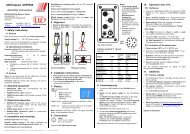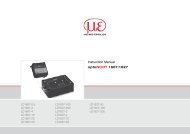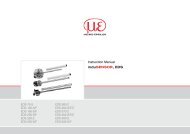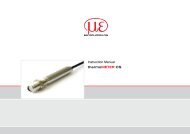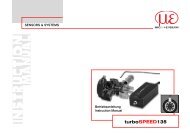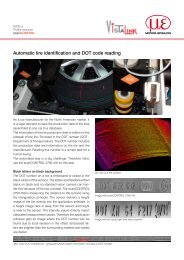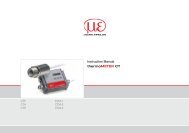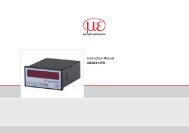Data sheet automationCONTROL (PDF, 626 KB) - Micro-Epsilon
Data sheet automationCONTROL (PDF, 626 KB) - Micro-Epsilon
Data sheet automationCONTROL (PDF, 626 KB) - Micro-Epsilon
You also want an ePaper? Increase the reach of your titles
YUMPU automatically turns print PDFs into web optimized ePapers that Google loves.
<strong>automationCONTROL</strong>Robot painting with ATENSOR LS1-Technology
<strong>automationCONTROL</strong> - a u t o m a t i c r o b o t p a i n t i n g a n d<strong>automationCONTROL</strong>DPS 8005.TScan-technology based onLaser-triangulationLaserCamera<strong>automationCONTROL</strong> DPS8005.T is a system thatcan be fully integrated to different types of automaticpaint robot. The different parts are scannedduring the process. Subsequently for each objectone or more individual robotic programmes arecreated and automatically transmitted to theprocessing robots.Due to high programming effort, the limits ofcommon automation systems are quickly reachedin terms of different parts and types of component.Using the DPS 8005.T any objects can bepainted using different versions of robots.Precise proliferation of optionsAutomation in industrial environments is a challengewhen it comes to processing different partsor components. Regardless of the number ofsingle parts, components or finished products,the processing of these different objects requiresextensive, accurate programming of the robots.The innovative, high resolution scanning technologyused by the DPS 8005.T system enablesprecise digitalisation and further processing of 3Ddata. Even the smallest details such as elementsof a combustion engine can be detected reliablyand considered during processing. Robot tracksare automatically generated and are adaptedto the actual shape of the object on the basisof 3D data. Therefore, collisions are avoidedand processing cycles can be optimised andautomated.BenefitsThe automated paint robot process DPS 8005.Tensures the quality of the paint finish. Independentof the batch size, the automated paintprocess can be extended to an unlimited numberof versions.Geometry robot tracks have to be created andoptimised in the case of common programming.This often results in idle time, as well as a reductionin capacity utilisation of industrial robots.<strong>automationCONTROL</strong> allows 100% capacity utilisationof any application.PROCESSING STEPSThe automated processing of the object to be painted is performed in two steps.► Area► DetailThe development of paint tracks for each partis done automatically. The user can determineareas for different planning and processingstrategies. Furthermore, global parameters canbe set up. During track planning, the tracksare adapted to the actual surface and therobot movements in the processing area areoptimised.If there are special processing steps requiredfor particular geometries, these are achievedthrough detailed processing. Examples hereinclude dirty locations or undercuts which arevery difficult to access. Areas that need to becleaned or painted are processed with predefinedmovements. Therefore, setting specificpaint parameters is possible. The actualgeometry of the total part is considered duringthe processing.Area: Automatic track planningDetail: Movement planning2
processing with ATENSOR LS1-TechnologyScanPlanningprocessing► Laser-triangulation► 3D-data► Position determination► Development of tracks► Detailed planning► Programming► Cleaning► Paint► PreserveComplex geometriesEven in the case of complex geometries, applyingrobots has its limitations. Due to many differentversions and add-on pieces, common trackplanning becomes difficult. Therefore, the effortrequired to ensure safe robot processing increasesconsiderably. Often the only alternative hereis manual processing.The scanning technology of the DPS 8005.T canbe adapted to complex geometries such as thechassis of a truck. Furthermore, each detail isdigitalised. The measurement results are thereforereliably displayed in their total 3D data structures.Robot tracks are automatically produced andadapted to the actual shape of the object in 3D.Therefore, collision is avoided and as a result, theprocessing can be optimised and automated.Layer thicknessThe layer thickness of 100% that is achieved witharea processing is attained for complex geometriesat approx. 70% of the surface area. Areasthat are difficult to access such as undercutsare painted using detailed processing. Therefore,even complex geometries can be paintedautomatically. Only in exceptional cases wherethe robot paint guns are restricted will special,manual paint touch up guns be required.Layer thickness in %Surface processing Detail processing Touch-Up1008060402000 20 40 60 80 100Coverage in %Degree of covering compared with layer thicknessduring automated paintSavings potentialPaint savings Personnel Robot utilization100%100%80%60%40%50%20%20%0%Saving potential of <strong>automationCONTROL</strong>Robot-based paint systems that use automation-CONTROL enable savings in paint usage of morethan 20% compared to manual painting.Furthermore, automated systems allow reductionsin the applied load, as well as reducing thenumber of paint staff by an average of 50% in shiftwork.Compared to common robot programmingwhere often production must be interrupted, byapplying <strong>automationCONTROL</strong> the robots arefully utilised.Manual paint3
BENCHMARKING DATAThe DPS 8005.T system for the automatic development of robot programmes for the cleaning andpainting of compression ignition engines features the following benchmarking data:Further applications<strong>automationCONTROL</strong> is based on the ATENSORLS1 technology and can be used for non-contactand contact applications.Scan area:1,500 mm x 1,500 mmResolution:1 mmNumber of scanners: 8Hardware:Industrial standardOrder management: DatenbaseUser management: 3-stagesProgram parameter: configurableHigh availability:Remote support:Line integration:Program transfer:Scan speed:Scan duration:Programming time:yesyesProfiNETFTP2.7 m/min25 s during the process180 sAmongst these applications are:► Grinding► Shot blasting► CO 2cleaning► Painting► Preserving► Polishing<strong>automationCONTROL</strong> is typically applied inproduction environments that are equipped withprocessing robots and corresponding automatedhandling/conveyor techniques.Example: shot blastingATENSOR Engineering and Technology Systems GmbHIm Stadtgut A2 · 4407 Steyr-Gleink · AustriaFon. +43 7252 70690-0 · Fax +43 7252 70690-500office@atensor.com · www.atensor.comMICRO-EPSILON MESSTECHNIK GmbH & Co. KG · www.micro-epsilon.de4





